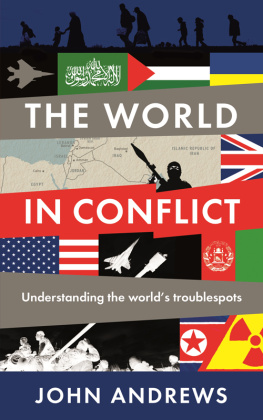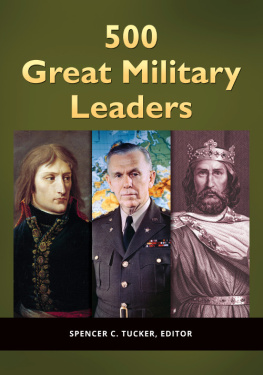

Copyright 2016 by ABC-CLIO, LLC
All rights reserved. No part of this publication may be reproduced, stored in a retrieval system, or transmitted, in any form or by any means, electronic, mechanical, photocopying, recording, or otherwise, except for the inclusion of brief quotations in a review, without prior permission in writing from the publisher.
Library of Congress Cataloging-in-Publication Data
Names: Tucker, Spencer, 1937 editor.
Title: World War I : the essential reference guide / Spencer C. Tucker, editor.
Other titles: World War One
Description: Santa Barbara, California : ABC-CLIO, 2016. | Includes bibliographical references and index.
Identifiers: LCCN 2015043398 | ISBN 9781440841217 (alk. paper) | ISBN 9781440841224 (eISBN)
Subjects: LCSH: World War, 19141918Encyclopedias. | World War, 19141918Sources.
Classification: LCC D510 .W68 2016 | DDC 940.303dc23 LC record available at http://lccn.loc.gov/2015043398
ISBN: 978-1-4408-4121-7
EISBN: 978-1-4408-4122-4
201918171612345
This book is also available on the World Wide Web as an eBook.
Visit www.abc-clio.com for details.
ABC-CLIO
An Imprint of ABC-CLIO, LLC
ABC-CLIO, LLC
130 Cremona Drive, P.O. Box 1911
Santa Barbara, California 93116-1911
This book is printed on acid-free paper 
Manufactured in the United States of America
For Dr. John Wood,
distinguished eye surgeon,
humanitarian, friend
Contents
Entry List
Primary Documents List
Introduction
Succinctly put, World War I was the most important single event of the 20th century. Almost all of the predictions of 1914 were proven wrong. The belief of a short war over by Christmas gave way to a four-year-long slaughterhouse and the largest conflict in world history to that point. Victory was almost indistinguishable from defeat. The human costs alone were staggering. More than 68 million men had been mobilized, and at least 10 million had died (8 million from combat and the remainder from disease and malnutrition). Another 21 million men were wounded, and nearly 8 million had been taken prisoner or declared missing. In the French and Russian Armies, three-quarters of the men were casualties. At least 6.6 million civilians also perished, reportedly some 1 million of these starving to death as a consequence of the British blockade. These heavy casualties fueled pacifist sentiment, especially in Britain, and helped prevent timely rearmament in the Western democracies in the 1930s against Adolf Hitlers Germany.
World War 1 introduced or saw increased use of new weapons, including the tank, airplane, machine gun, and submarine. The war also introduced penicillin, while attention was given to shell shock, now known as post-traumatic stress disorder. Large numbers of women entered the workforce because of the war, which would have profound social, economic, and political ramifications. The war also greatly influenced literature and the arts.
All commentators agree that World War I was one of the most influential events in all history. The war was far more than a vast military holocaust. It toppled all of continental Europes great dynastic empires: the German, Austro-Hungarian, Ottoman, and Russian. The war provided the opportunity for the Bolsheviks to seize power in Russia in November 1917.
The war consumed the capital and treasure accumulated during the course of several centuries. Its direct costs were staggering, and the indirect costs were even greater. The war reshuffled the international balance of power and made the United States the leading creditor nation and world financial capital. The war also greatly stimulated unrest in the colonial areas of the world, paradoxically advancing both Zionism and Arab nationalism. U.S. president Woodrow Wilsons wartime statements about self-determination of peoples and fighting to make the world safe for democracy found ready acceptance among peoples living in subjugation overseas.
The conditions spawned by World War I occupied central place in the rise to power of Benito Mussolini in Italy and Adolf Hitler in Germany. Hitlers efforts to reverse the outcome of the Great War, as World War I is also known, and those of Mussolini and the Japanese nationalists to fish in troubled waters in order to advance their nations territorial ambitions, coupled with deep divisions among the victorious powers of France, Great Britain, and the United States regarding enforcement of the peace settlement of 1919, brought World War II. In a very real sense, World War II was simply a continuation of World War I.
Spencer C. Tucker
Overview of World War I
The most potent weapon for the Allies in World War I was the British Royal Navy. Britain also had half of the worlds merchant marine, vital for securing and transporting war materials. On land the Central Powers had the advantage, as the German Army was the worlds largest and most efficient. The Allied combined population was, however, much larger than that of the Central Powers279 million compared to 120 millionand the Allies were much better placed economically. If the war could be prolonged and all other factors remained equal, economics and demography would give them victory. The German General Staff had no intention of fighting a prolonged war, however.
The Germans planned a quick victory over France and then a turn to deal with a slowly mobilizing Russia. German Army chief of staff General Helmuth von Moltke had modified the original German Schlieffen war plan that placed overriding strength on the right wing in favor of strengthening forces against the anti-cipated French offensive in Lorraine. Then while the campaign was in progress, he detached some 80,000 men from the right wing and sent them east against the Russians, who had moved faster than anticipated. Given the excellent French rail net that allowed rapid troop movements, the Schlieffen Plan might not have worked in any case, but Moltkes changes were fatal.
French Army chief of staff General Joseph Joffre ignored the likely German thrust through Belgium and placed three of his five armies on the borders of Alsace and Lorraine in order to retake those two provinces lost to Germany in 1871. Only one army was in the critical area of the Belgian frontier. Thanks to the French railroads, however, Joffre was able to shift forces northward quickly.
The German advance into Belgium went as planned. Meanwhile, the British Expeditionary Force (BEF) arrived in France. Commanded by Field Marshal Sir John French, the BEF was small but highly trained. The BEF and the French were, however, forced into a withdrawal to within 25 miles of Paris.
The fall of the city seemed certain, but the Allies now enjoyed a slight numerical advantage, and in the First Battle of the Marne (September 512) they halted the Germans. This battle denied Germany the quick victory it needed to win the war. General Erich von Falkenhayn now replaced Moltke as chief of the German General Staff.
The Race to the Sea ensued, with each side endeavoring to turn the others flank. In the First Battle of Ypres (October 22November 22), the British turned back Falkenhayns effort to secure the channel ports. This battle ended the war of movement and began a war of trenches and stalemate.
The front now extended some 350 miles from the English Channel to the Swiss frontier. From the end of 1914 until early 1918 there was no change of more than 10 miles in the front lines on the Western Front, the sole exception being a 1917 voluntary German withdrawal from the Noyon salient. Determined to drive the Germans from France, Joffre pressed the offensive but met failure in the First Battle of Artois (December 17January 4) and the First Battle of Champagne (December 20March 17).
Next page
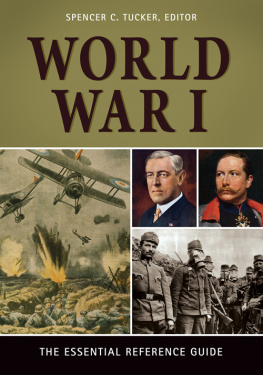
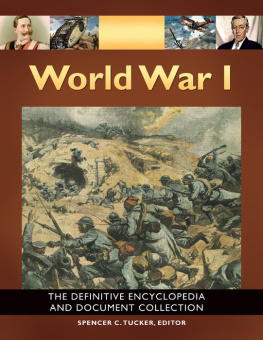
![Spencer C. Tucker - World War II [5 Volumes]: The Definitive Encyclopedia and Document Collection](/uploads/posts/book/128138/thumbs/spencer-c-tucker-world-war-ii-5-volumes-the.jpg)
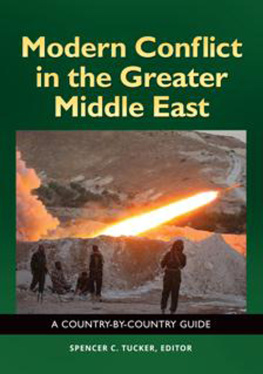

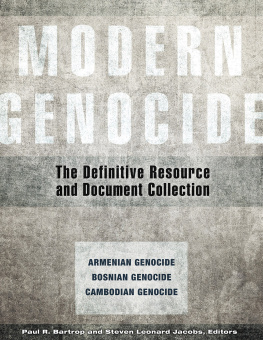
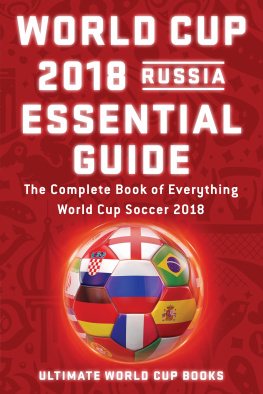
![James Francis LePree Ph.D. (editor) - The Byzantine Empire [2 volumes]: A Historical Encyclopedia](/uploads/posts/book/296844/thumbs/james-francis-lepree-ph-d-editor-the-byzantine.jpg)
![Patrick G. Zander - Fascism through History [2 volumes]: Culture, Ideology, and Daily Life](/uploads/posts/book/262756/thumbs/patrick-g-zander-fascism-through-history-2.jpg)
